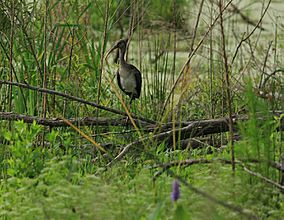Harris Neck National Wildlife Refuge facts for kids
Quick facts for kids Harris Neck National Wildlife Refuge |
|
|---|---|
|
IUCN Category IV (Habitat/Species Management Area)
|
|

A juvenile white ibis in the Harris Neck National Wildlife Refuge
|
|
| Location | McIntosh County, Georgia, United States |
| Nearest city | Riceboro, Georgia |
| Area | 2,762 acres (11.18 km2) |
| Established | 1962 |
| Governing body | U.S. Fish and Wildlife Service |
| Website | Harris Neck National Wildlife Refuge |
The Harris Neck National Wildlife Refuge is a special place in McIntosh County, Georgia, USA. It was created in 1962 to protect nature. This refuge covers about 2,762 acres (11.18 km2). It has different types of land, like saltwater marshes, grassy areas, and forests with many kinds of trees. You can find it on an old military airfield, about 30 miles (48 km) southwest of Savannah, Georgia.
Contents
A Look Back: Harris Neck's History
Harris Neck is a piece of land that sticks out into the water, called a peninsula. It's about 30 miles (48 km) south of Savannah, Georgia. The closest town is South Newport, which is six miles (10 km) to the west.
This area was first called Dickinson's Neck. But in the mid-1700s, a man named William Thomas Harris became the main landowner. So, the name changed to Harris Neck.
Life After Slavery
In 1865, after the American Civil War, a plantation owner gave land here to a former slave. Many Black families then moved to the area. They built homes and even factories to process oysters and crabs. This shows how communities grew and thrived in Harris Neck.
The First Airfield
Between 1929 and 1932, a small airfield was built at Harris Neck. It was called "Harris Neck Intermediate Field Site #8." This airfield was a safety stop for commercial planes flying between Richmond and Jacksonville, Florida. It had two grassy runways and was lit up at night. However, it didn't offer many services for planes.
This first airfield closed to the public on January 1, 1942. This happened when the Civil Air Patrol started using it for anti-submarine flights during World War II. Later that year, it was left empty when a new military airfield was built nearby. Today, you can't find any signs of this original airfield.
Harris Neck During World War II
In the middle of 1942, the Army Air Force decided to build a large military base at Harris Neck. To do this, the government needed the land. Families living there were given two weeks to move out. They were paid for their land so the military could build the airfield. This included a large estate with a mansion and a deep-water dock.
Construction started on July 15, 1942. The original plan was for two runways. But then the Army decided to add a third runway, which meant they needed even more land. By December 1942, soldiers were stationed at the new Harris Neck facility. It officially became an auxiliary airfield in January 1943. It helped support a larger airfield in Florida.
What's Left of the Airfield Today?
Today, it's hard to tell that Harris Neck was once a busy military airfield. Most of the old runways, taxiways, and bunkers are now covered by plants. The only building that still stands is a water fountain. It likely belonged to the old Livingston House estate. The area is very overgrown, and some parts are marked with "keep out" signs.
Some of the families who used to live here, and their descendants, are still trying to work with the government. They hope to find a way to return to their land without harming the wildlife refuge.
Protecting Nature: The Wildlife Refuge
The Harris Neck National Wildlife Refuge (HNNWR) was officially created in 1962. The land, including the old World War II Army airfield, was transferred to the United States Fish and Wildlife Service. The refuge protects 2,762 acres (11.18 km2) of saltwater marsh, grasslands, forests, and farming areas.
Amazing Wildlife
Harris Neck NWR is a very important place for many animals, especially birds.
- In the summer, thousands of egrets and herons build their nests in the swamps.
- In the winter, many ducks gather in the marshland and freshwater pools. You might see mallards, gadwall, and green-winged teal.
- The refuge is also a key nesting area for the wood stork, a large wading bird.
Visiting the Refuge
If you want to explore the refuge, there are over 15 miles (24 km) of paved roads and trails. These paths make it easy to see the different habitats and spot wildlife.
Harris Neck is also part of the Georgia's Colonial Coast Birding Trail. This trail was started in 2000. Harris Neck was chosen because it's easy to get to and has many different kinds of birds. It's a great spot for birdwatchers!



